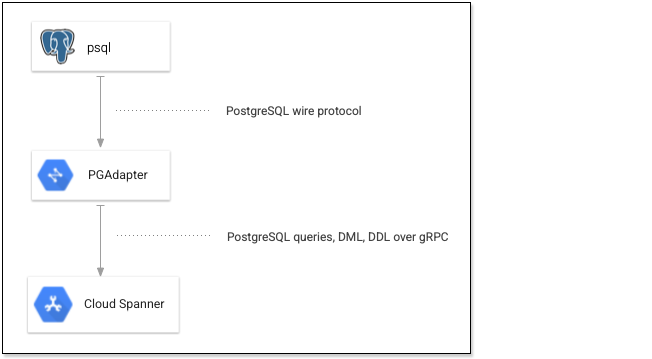This page provides an overview of PGAdapter. To learn how to start PGAdapter, see Starting PGAdapter.
PGAdapter is a sidecar proxy that supports the
PostgreSQL interface for Spanner. It runs on the same
machine as the application and exposes an endpoint on localhost that supports
the PostgreSQL wire protocol. It translates the PostgreSQL
wire protocol into the Spanner wire protocol, gRPC. With this proxy
running locally, a PostgreSQL client such as psql can connect to a
PostgreSQL-dialect Spanner database.
The following diagram shows how psql connects to Spanner through PGAdapter.

PGAdapter supports simple and extended query modes, and supports any data type that the PostgreSQL interface for Spanner supports.
PGAdapter execution environments
You can run PGAdapter by using one of the following methods:
- Standalone. PGAdapter is supplied as a JAR file and runs standalone in the JVM.
- Docker. PGAdapter is also packaged as a Docker image.
- Cloud Run. PGAdapter can be deployed as a sidecar proxy on Cloud Run.
- Sidecar proxy. A typical use as a sidecar proxy is in a Kubernetes cluster.
- In-process. Your Java application code can use the supplied JAR file to create and start a PGAdapter instance.
For details about these methods, see Start PGAdapter.
Authorization with PGAdapter
PGAdapter determines the service account or other Identity and Access Management (IAM) principal to use for the connection by examining the credentials that you specify when you start it. The IAM permissions granted to that principal determine the permissions that the connecting application has on the database.
When fine-grained access control is in use, you can optionally specify a
database role when you start PGAdapter. If you specify a database role,
then PGAdapter uses fine-grained access control when it sends requests for queries
and DML statements. This requires the IAM permission
spanner.databases.useRoleBasedAccess and, for database roles other than
public, the spanner.databaseRoles.use permission. The privileges granted to
the database role determine the operations that the connecting application can
perform. If you don't specify a database role, then the database-level
permissions that are granted to the IAM
principal are used. To perform DDL statements, the principal must have the
spanner.databases.updateDdl permission.
For more information, see About fine-grained access control and Access control with IAM.
What's next
- Start PGAdapter
- Learn more about the PGAdapter GitHub repository.
- Learn more about PostgreSQL drivers and ORMs for a table of PostgreSQL drivers and ORMs that PGAdapter supports.
